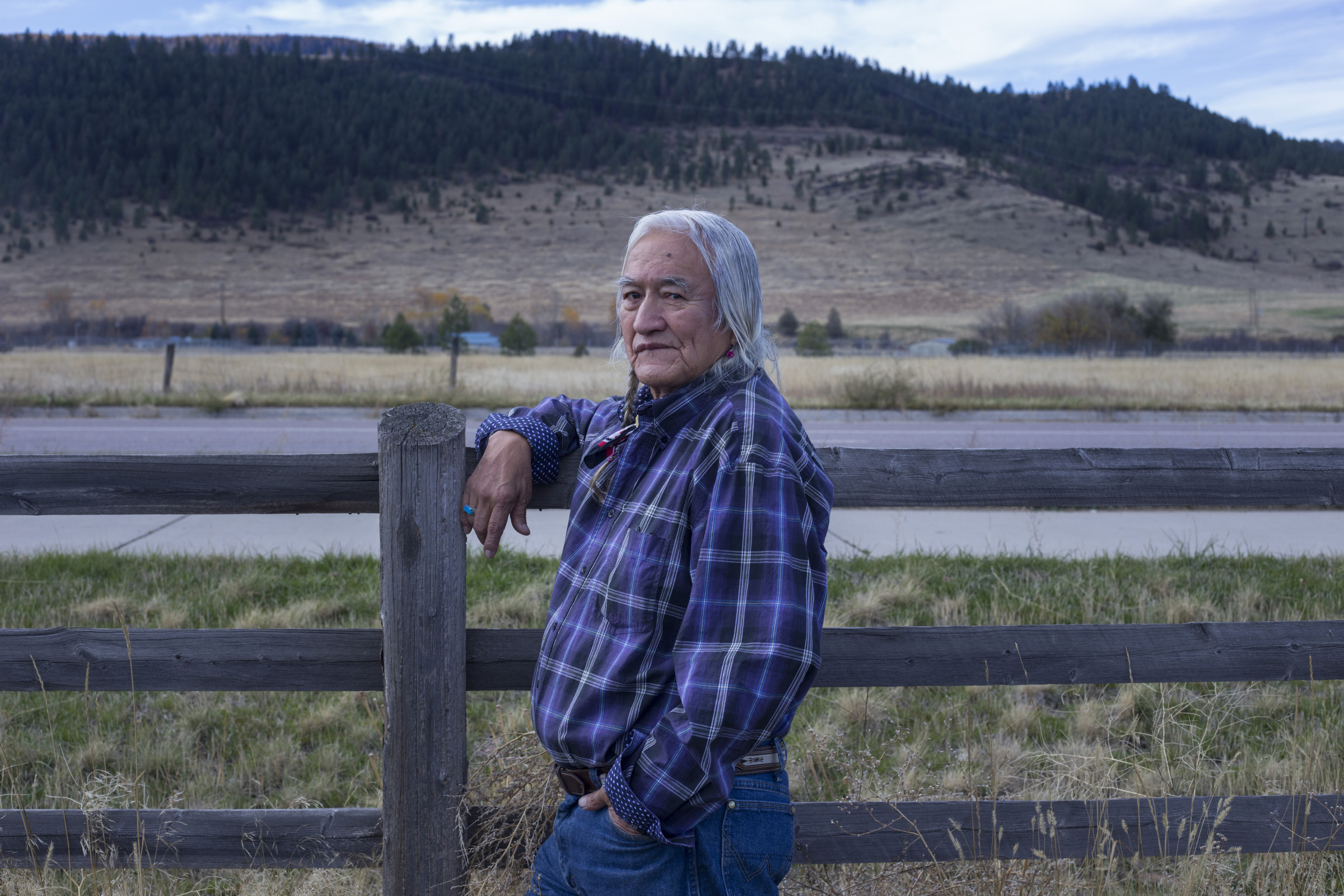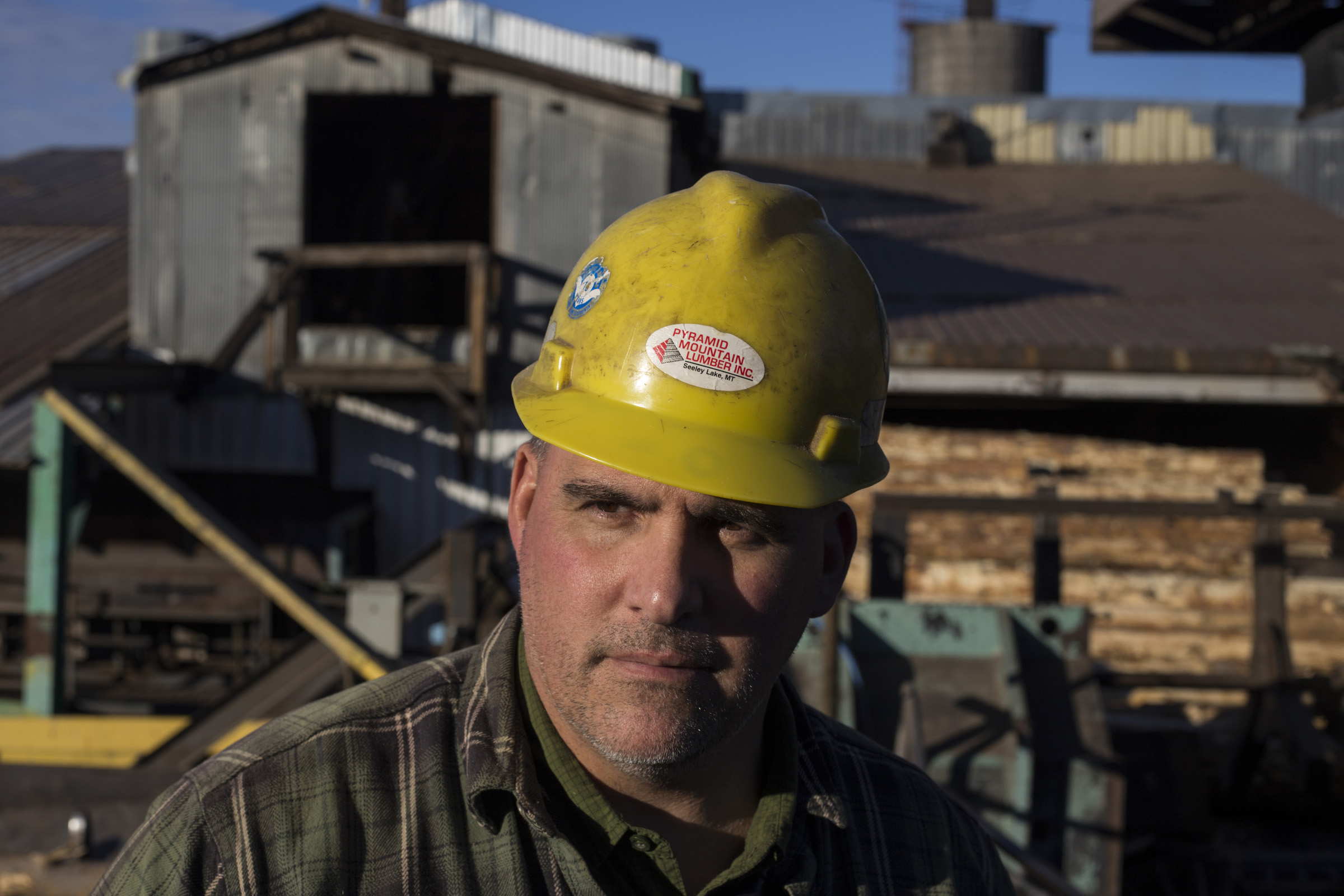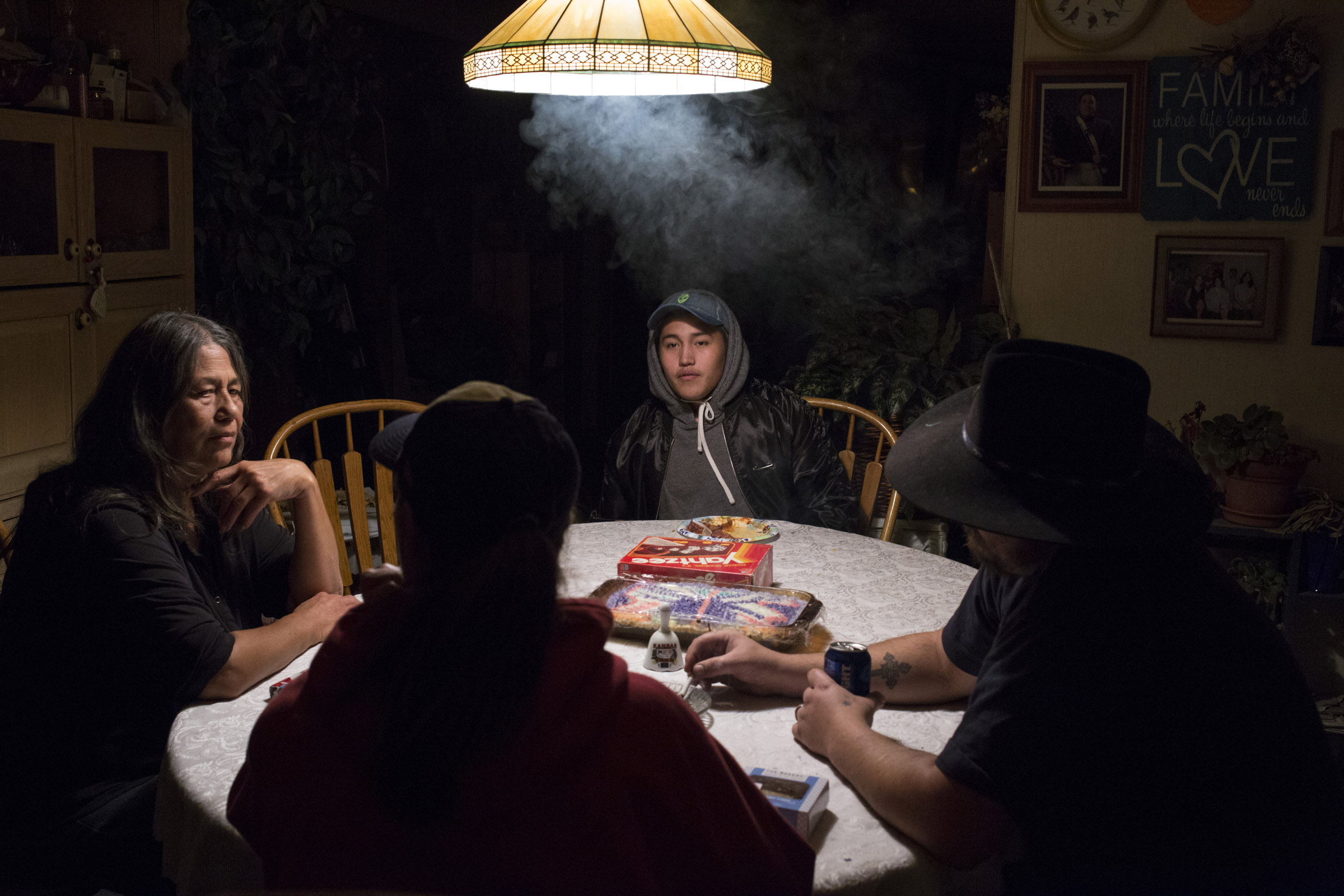Montana:
Introduction

People are shaped by the environment in Montana. Under an expansive sky, it’s easy to feel lonely and free all at once. Fly fishing is religious, and hiking is spiritual. The mountains are a grounding force, and the rivers bring hope. People live, work and recreate on the landscape, and this shared experience can bring together people of diverse politics. But tensions over how land is used — and who gets to decide — can also cause divisions.
After a prolonged drought this summer, wildfires burned more than a million acres across Montana. Two firefighters were killed, communities were evacuated or forced to leave due to hazardous smoke conditions, and old tensions over public land resurfaced.
Still, fire plays an important ecological role in Montana’s forests and grasslands, and many Montanans are transitioning away from an old ideology that no fire is a good fire. But like the mosaic that fire leaves behind on the landscape, the values held by the people who live here are complex.
Audio reporter Rachel Cramer explores some of those values and an effort to find common ground. Montanans on both sides of the aisle are pushing to change how firefighting is paid for — so it doesn’t use up the money for preventing serious fires. Writer Eric Bosco investigates a proposed bill that would do just that, and why bipartisan support isn’t enough to ensure it will pass.
With climate change and 100 years of fire suppression, wildfires have become more commonplace in the American West. Videographer Mahlia Posey shares tips on how homeowners can make their property “Firewise” — or resistant to wildfires, and photographer Brittany Greeson showcases the rejuvenating aspects of fire, both for wildlife and the people who have lived on this land for thousands of years. As writer Gabriel Sanchez shares, the Salish and Kootenai Tribes have been using fire to manage landscapes in western Montana since long before European settlers arrived.
Wildfires can be destructive forces of nature. They can drive a wedge into already divisive issues, and lead to misplaced blame. But they can also be an opportunity for change and collaboration. Wildfires are the new reality of the American West. Can Montanans learn to live with them and each other?
Montana:
Summer of Smoke
Tucked into the thickly forested valley between the Mission and Swan mountain ranges of western Montana, the small tourist town of Seeley Lake feels tranquil after a dramatic wildfire season. Along the main drag, locals are getting breakfast at Pop’s Place, a diner decorated with deer mounts and fly-fishing art.
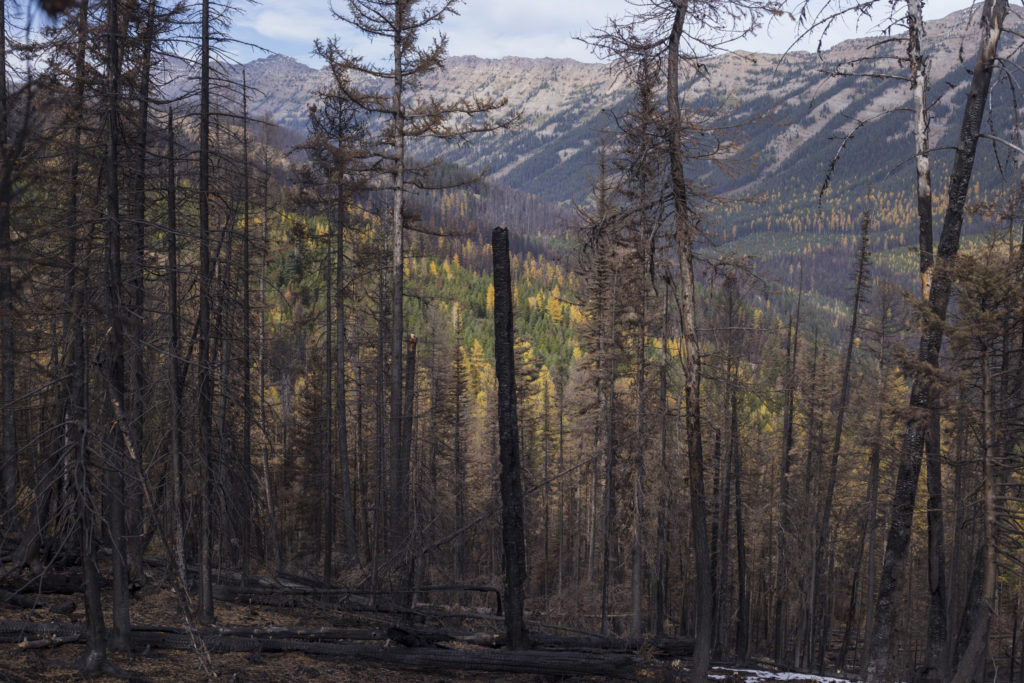
Tim Clark, the owner, says his business largely depends on summer tourism. He lost about two-thirds of his usual profit while the lightning-caused Rice Ridge Fire burned from July into September, just a few miles from his door.
Clark lays the blame on environmental lawsuits that stop timber projects in national forests. In his view, logging is crucial for reducing flammable material in a forest and preventing large fires like Rice Ridge.
“I breathed air for 50 days that I’m probably going to suffer from for the rest of my life, and it all could have been prevented with forest management,” says Clark. “Loggers are probably the best conservationists we have. They don’t want to lose their livelihood, so they’re going to take care of their crops.”
Wildfires burned more than a million acres across Montana this year, making it one of the most expensive fire seasons since 1999. The Rice Ridge Fire burned 160,000 acres of mostly national forest land, and forced the evacuation of most of the town of Seeley Lake.
While the smoke has cleared, the debate over wildfires and forest management is ongoing. Some Montana lawmakers are blaming what they call “environmental extremists” who’ve managed to stop some logging. But ecologists say it’s more complicated than that.

Just down the road in Seeley Lake is Pyramid Mountain Lumber. A worker in a skid loader there is moving a pile of freshly cut logs across the yard. The air smells like pine and shimmers slightly from all the sawdust.
This is the oldest family owned and operated sawmill in the state. There used to be seven mills in Missoula County. Now there are just seven left in Montana. Plant manager Todd Johnson says it’s also the largest employer in the community with about 150 employees, and he’d like to be able to hire more.
“We can put people to work on the ground, good paying jobs that are paying taxes in the community, have kids in this community,” says Johnson. “It’s a resource that we believe is being underutilized. And you have to balance. We believe it’s out of balance.”
Johnson says making it easier to log national forests, especially around communities, would support jobs and reduce the size and severity of wildfires.
“You’re never not going to have fires, but if you take away some of the fuel, you’re not going to have the large fires that we have,” says Johnson.
Republican Congressman Greg Gianforte of Montana called out environmental groups for stopping a logging project near the Rice Ridge Fire. The Stonewall Vegetation Project, Gianforte said, is exactly what Montana needs more of — cutting down more trees on national forests to reduce the size and intensity of wildfires in the state.

“We’re tied up in knots through extensive and ridiculous permitting processes, and frivolous lawsuits from environmental extremists,” Rep. Gianforte said at a press conference in August.
The Alliance for the Wild Rockies is one of the groups that sued to stop Stonewall. Executive director Mike Garrity says it’s not uncommon for him to get angry phone calls and anonymous threats to burn down his house. He says Stonewall would have violated the Endangered Species Act by destroying lynx habitat.
“We sue to get the Forest Service to follow the laws that Congress passed and the president signed,” says Garrity. “So because they’re losing in court all the time, it’s much easier for them to say, ‘Well, it’s these radicals — or whatever name they want to call us — who are causing the problem.’”
Garrity says his organization does not oppose logging in general, particularly on the edge of a community.
“A lot of politicians or the timber industry have claimed we’ve shut down forests,” says Garrity. “That’s not true. We focus on the timber sales we think are really bad.”
Stepping back from the politics and litigation, there are many misconceptions about wildfires and the role of forest management, says Andrew Larson, a forest ecologist at the University of Montana.
“I think one of the most important things people need to recognize, living in western Montana, is that we live in a flammable landscape,” says Larson. “We need to expect fires to burn in places that we live, where we hunt, where we recreate.”

Larson says fire is a key part of western Montana’s ecosystems. For example, many tree species are adapted to release seeds only after a major fire. Fire also clears out thick vegetation, allowing sunlight to reach the forest floor and support the growth of young trees.
But Larson says forest management — including some logging followed by prescribed burning — has a role to play in certain types of dry forests at low-elevations near communities. In low-wind conditions, this kind of management can stop or at least slow down the progress of a fire. Still, Larson says forest management is not supposed to prevent forest fires.
“So that’s a huge misconception,” says Larson. “Very frequently, public figures will either make that statement or imply that when we manage forests, the outcome will be no fire. And that is absolutely not the case.”
Disagreements over how to manage forests can be impassioned and angry. In 2009, a new effort to find collaborative solutions brought together a spectrum of people who care about the safety of their communities, jobs and wildlife.
Jim Burchfield, a professor of forest social sciences at the University of Montana is part of this effort, called the Southwestern Crown Collaborative. Today he’s on a field trip with other people looking for common ground. A group of residents, scientists and conservationists are touring part of the forest the Rice Ridge Fire burned near Seeley Lake.
The Swan Range is covered in a brilliant display of green conifers and golden larch. Creeping up from the valley is an amoeba-like patch of burned forest.
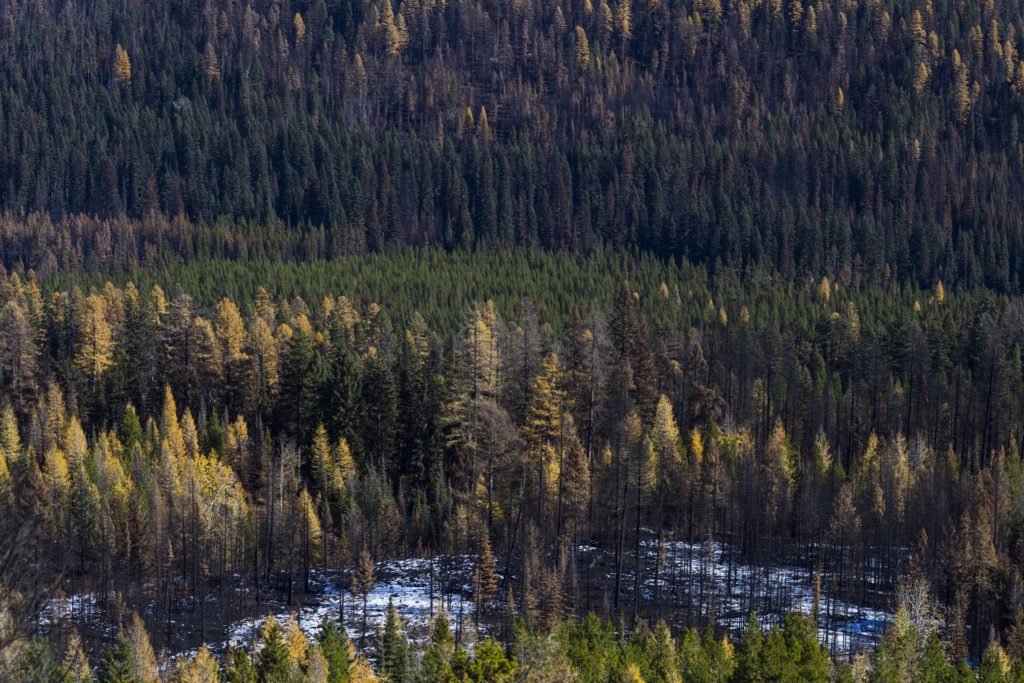
“It’s awfully easy to think of fire as being homogeneous, and it’s not,” says Burchfield. “And I don’t think our response should be homogeneous either. That’s why these collaboratives are so interesting, is that we get to think through some of the nuances of what we might want to do.”
The Southwestern Crown Collaborative is an independent, volunteer-based project that works with the Lolo, Flathead and Helena National Forests on restoration plans, with the goals of reducing fire risk and boosting local economies.
Gary Burnett, a co-chair of the collaborative, says finding common ground is a long, often challenging process, but necessary.
“If we work at the edges, we just sit at the edges and argue with each other,” says Burnett. “And it’s not that those values don’t count at the edges, but we’re not getting work done. We’re not building trust. We’re not even necessarily being respectful.”
The Montana Wilderness Association’s Zack Porter, also a member of the collaborative, says wildfires are sometimes used to promote political agendas and increase logging. But this group, he says, supports science-based decision making and local timber mills that care about stewardship.
“There’s a difference between that and going back to an era of timber harvest in western Montana that I really don’t think is something that most Montanans would ever want to go back to,” says Porter.

Porter says many Montanans are still transitioning from the old ideology that no fire is a good fire. But that doesn’t mean that living with wildfires is easy.
“I have a 16-month old,” says Porter. “We had to keep her inside for a month and a half. We could not go outside. We barely wanted to walk to our car.”
Still, Porter says wildfires are the reality of western Montana.
“If we are going to choose to live in this landscape for all of the things that we love about it, we are going to have to learn how to live with the other aspects that are less pleasant for us,” says Porter.
After last summer, a lot of Montanans are talking about how to live with fire. There was a forum on that topic at the University of Montana last month. Phil Higuera, a fire ecologist at the university, said the question of how much forests should be managed versus left to “natural processes” is complicated by climate change.
“It’s not surprising if humans are increasing temperatures, then some degree of the wildfires that we have seen in the last 30 years have some human fingerprint on them,” said Higuera. “And I think it forces us then to start to acknowledge that we need to take account for management actions we’ve done in the past. And think hard about what we value, why we value that, and how that varies across the landscape.”
Higuera said that whenever values are involved, there will always be tension. At the moment, some lawmakers are trying to protect traditional industries and ideas about forest management. Some environmental groups are making use of longstanding environmental laws to protect what they value. Others are looking for ways to collaborate to help Montana find a way to live with fire.
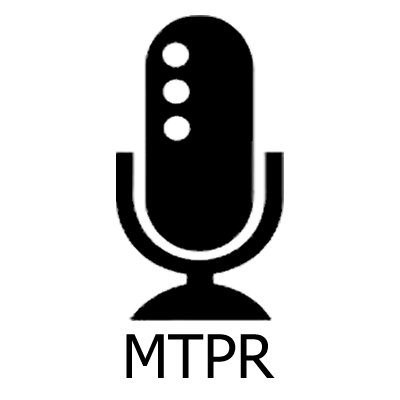 A version of this story aired on Montana Public Radio on November 6, 2017
A version of this story aired on Montana Public Radio on November 6, 2017Montana:
Photo Essay: Learning to Live With Fire
In western Montana, wildfires are a part of life. Their effects create a colorful mosaic across the mountain range, a patchwork quilt of scorched earth, brilliant yellow larches, deep green fir trees and the bright green of new growth. Wildfires don’t only destroy – they also drive regeneration. Native Americans have been using fire to shape forest ecosystems since long before Europeans arrived — a practice that’s now embraced by the U.S. Forest Service.
On the Flathead Reservation, I pursued a visual theme of regeneration in the land and in the people. I searched for parallels in daily life, and how families pass down knowledge through the generations. I looked for photographs that conveyed the 10,000-year depth of native heritage and how teenagers find themselves caught between that heritage and the demands of a technology-driven society. I learned about the subtleties of the Salish language and how it has been used for millennia to convey deep cultural meaning and context.
For this reporting, it was important to me to give as much weight to the history as to the scene in front of me. While it was challenging, I received help from the elders in the community. Through our conversations, I was able to visualize elements of the past, such as their approach to wildfire management.
Watching the Confederated Salish and Kootenai Tribes’ Division of Fire ignite a prescribed burn, the methods were just as modern as any other fire department. Elders and youth alike reminded me that despite common stereotypes about Native people, they’re not stuck in the Stone Age. In fact, they’ve adapted modern technology to better apply their long-held knowledge of western Montana’s fire-dependent ecosystem.
Montana:
Fighting Fire with Fire
MISSOULA, Montana — In the mountains of western Montana — amid heavy breaths, radio chatter, banter and clanging gear — firefighters with the Confederated Salish and Kootenai Tribes climbed to a crest to light a fire. Their yellow-and-green uniforms, initially camouflaged by dried grass and trees, contrasted with the trench they dug into the dark dirt, to contain the prescribed burn.

“This is the easy part,” one of the firefighters said, explaining that setting controlled burns is easier than controlling wildfires.
Wildfires burned more than a million acres in Montana this summer, the third-highest toll in state history, reigniting a long-standing debate about how to manage public lands. But there is widespread agreement — from loggers to conservationists — that controlled burns could help prevent more of the state from going up in flames.
“If you burn more often, you don’t have as much fuel,” said Jim Riddering, a former hotshot firefighter and research associate professor at the University of Montana. “That’s an easy way to think about it. If you suppress fire, like we have, fuel is going to build up. Once it does burn — it’s inevitable that it’s going to burn — it’s going to burn more intensely and pose control problems.”
But using fire to fight fire hasn’t always been an accepted practice. In the late 19th and early 20th centuries, the mainstream belief was that quelling wildfires promoted ecological stability — and protected human lives and livelihoods. Wildfire suppression became standard practice, including the U.S. Forest Service’s “10 a.m.” policy, introduced in 1935, that required all fires be extinguished or contained by 10 a.m. the day following their discovery.
“These forests are supposed to burn, and they’ve been doing it for a very long time,” Riddering said. “We’ve been very successful at fire suppression. We’ve got 100 to 110 years of being really good at suppressing fire, and it turns out that’s kind of problematic.”
Disrupting the frequency of low-intensity fires in the fire-dependent ecosystems of western Montana and the northern Rocky Mountains means that flammable vegetation that would have burned away instead stockpiled to fuel larger and fiercer blazes.
Policies started to change in the 1960s, but Native American tribes in western Montana have long understood the value of naturally-occurring fires — and intentionally setting fires.
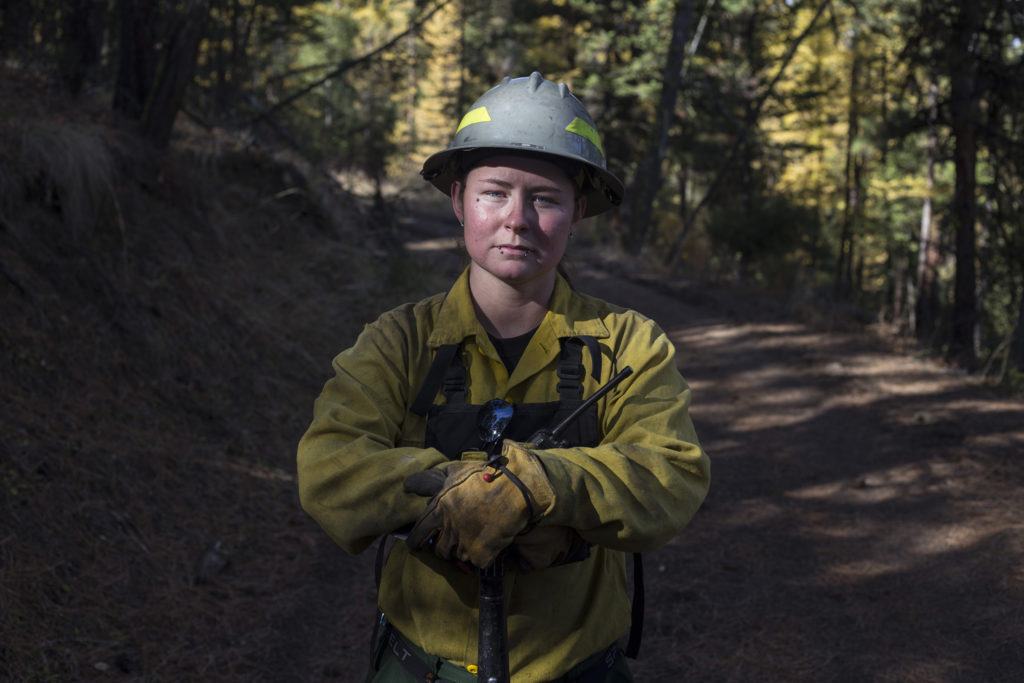
“This is a fire-shaped landscape, and fire exclusion produces ever-increasing fuel loads that move our forests further and further from their historic condition and more out of balance,” said Germaine White, information and education specialist with the Confederated Salish and Kootenai Tribes. “It’s a stunningly beautiful landscape out of balance. When you look at then-and-now photographs, you see that the Mission Mountains have natural fire mosaics, and those are absent now. It’s a landscape that’s ready to go up in flames.”
The U.S. Park Service website describes how settlers failed to grasp what Native Americans understood.
“Europeans held a view of fire, its effects and consequences, that was very different from the Native American view of the natural phenomena,” the report reads. “At the close of the 19th century, settlers concentrated on permanent husbandry of the forests to protect watersheds and forest products. Crops also were of concern when wildfire control was discussed. As fences began to create a patchwork across the once open expanses of prairie and forest, fire became an enemy capable of destroying all that had been achieved.”
For the people of the Confederated Salish and Kootenai tribes, fire was integral to achievement.
“Historically, fire was at the very heart of our traditional life,” White said. “Fire was used for cooking, it was used in ceremony, it was used to maintain trails, it was used to maintain plant and animal communities, and fire was used in spiritual practice. Fire was primary and fundamental.”
Today, firefighters again use fire to reduce fuels and restore habitats for wildlife, including elk and bison. The fires also restore the plants that produce the region’s beloved huckleberries and the camas bulbs that were once a staple food item to Native Americans and early settlers, according to data from the U.S. Forest Service.

But a host of obstacles still limits the size and number of prescribed burns. This year’s uncharacteristic blazes were compounded by built-up fuel and sudden drought conditions.
One of those obstacles is the people living in close proximity to forests. Since 1990, 60 percent of new homes in the U.S. were built in areas that are considered “wildland-urban interface” — meaning next to wildlands at risk of fire, according to a fire report from the Government Accountability Office. Beyond posing greater risks to lives and structures, these communities also hinder the reduction of fuels through controlled burns.
“Some residents resist fuel reduction treatments because they perceive the treatments as damaging the environment or because they want the privacy provided by the vegetation near their homes,” the report said. “The public’s tolerance of smoke from prescribed burns can be limited, which results in fewer prescribed fire treatments.”
Smoke levels are not measured solely by public opinion, but also by the Environmental Protection Agency, which is responsible for enforcing the Clean Air Act. Depending on air quality, land managers may not receive burn permits from state officials.
“There might be days that we really want to burn, and we have the weather,” said Darrell Clairmont, fire division fuels specialist with the Confederated Salish and Kootenai Tribes, “but we don’t have the wind to disperse the smoke. So, then, we don’t burn.”
He added that it’s challenging to work around inhabited areas of forest.
“It’d be easier for us to take a big area and burn it, rather than knocking it into little chunks,” Clairmont said. “There’s less open land now, because there’s more of us.”

Trees like the ponderosa pine and the Rocky Mountain lodgepole pine thrive in frequent low-intensity fires. Without those fires, however, more-combustible tree species have encroached in these ecosystems. When they burn, they burn hotter and taller, as flames engulf the crowns of the encroaching trees.
“There wasn’t a lot of brush in the mountains, it was more of an open landscape,” said Bob McCrea, Wildlands Operations Specialist with the Confederated Salish & Kootenai Tribes and a former smokejumper, who has fought fires since 1966. “It isn’t that way anymore.”
A federally-protected bald eagle’s nest can also throw a wrench in plans for a prescribed burn.
“The eagle nest was something that threw us out in the spring,” Clairmont said of a prescribed fire intended to restore elk habitat. “We’re trying to make up for this fall by doing it by hand and taking care it’s not on the nest.”
Instead of igniting the fire via helicopter, the firefighters in his division dug the containment line in the mountain, heeding a half-mile-long buffer they agreed to leave for the nest.
An unexpected limitation to the burns by the Confederated Salish and Kootenai Tribes has been the tribe’s elders.
“This is a cultural aspect,” Clairmont said. “In the springs, our elders will go out and collect different plants from different areas. So, we have to figure out where they’re going, because we’ve run into issues. Sometimes, where they go to collect plants, we’ve wanted to burn. So, timing is an issue as well.”
Of all the hurdles to prescribed burns though, Claremont said funding is the biggest. The money to fight fires is there, but that’s not always the case for forest maintenance and risk-reducing measures like controlled burns.
“The funding that I see fluctuates quite a bit,” Claremont said. “I would think that the next couple of years my funding might be pretty good because of the fire season we had this year. But, then, that’s going to go out of people’s minds. They’re not going to be concerned about it, and then it’ll be another big fire season.”
 A version of this story appeared in FLATHEAD BEACON on December 8, 2017
A version of this story appeared in FLATHEAD BEACON on December 8, 2017Montana:
Funding the Fight Against Forest Fires
SEELEY LAKE, Montana — This summer, as raging forest fires swept across the state, homes were evacuated, schools couldn’t open and plumes of smoke engulfed this scenic lake town flanked by twin mountain ranges.

Today, there’s no trace of the disruption in Seeley Lake, no smoke lingering in the air. But just a few miles away, the wildfires have left behind a mosaic of destruction. Some areas of the forest are relatively unburned, but there are swaths that look more like a moonscape — an ashen forest floor and black, dead trees.
Fires raged across the American Northwest this summer — dozens died in Northern California and billions have been spent to fight blazes that residents across the region are becoming accustomed to dealing with, as the changing climate creates longer fire seasons.
But as the need for preventive measures like reducing the forest fire fuel on the ground has heightened in Montana, the agency responsible for contracting such projects in the national service — the U.S. Forest Service — has a budget that has been dominated by the cost of fighting increasingly intense wildfires.
“We’re turning the Forest Service from a forest management agency into a firefighting agency,” said Democratic U.S. Senator Jon Tester of Montana in a phone interview. “And that’s not working very well, we need to fix it.”
Changing the funding model for fighting wildfires is something most people in Montana agree on — from environmental organizers in Missoula to loggers in Seeley Lake — regardless of who they voted for in the national election.
“I’m all for separating out the firefighting budget from the Forest Service’s operating budget,” said Tim Clark, a restaurant owner in Seeley Lake, who says he identifies as a political conservative. “That way they can get back to doing thinning like they used to.”
The Wildfire Disaster Funding Act, co-sponsored by Tester, is currently pending in Congress and would open up federal funds for natural disasters to cover the cost of fighting wildfires in national forests.

U.S. Representative Greg Gianforte (R- Montana) is a co-sponsor for the Wildfire Disaster Funding Act in the House, and U.S. Senator Steve Daines (R-Montana) supported a similar bill in 2015. Neither could be reached for comment on this story but Rep. Gianforte expressed commitment to securing more federal funding for fighting Montana wildfires in a recent press release.
“I look forward to working with my colleagues to ensure Montana receives the aid we need and to enact meaningful forest management reforms to improve the health of our forests and reduce the severity of future wildfires,” Gianforte said in the release.
But bipartisan support in Montana doesn’t guarantee the bill will pass in Washington. In 2014, Republican House Speaker Paul Ryan warned members of his party against backing a similar Wildfire Disaster Funding Act, citing “increased federal spending.” The legislation sat for six months, and the congressional session ended without a vote.
A 2015 Forest Service report states that the average fire season is 78 days longer than in 1970, which results in escalating costs for fighting wildfires. The rising costs have a debilitating impact on the agency’s ability to deliver on its other mandates.
“The growth over the past 20 years of the portion of the Forest Service’s budget that is dedicated to fire, and the debilitating impact those rising costs are having on the recreation, restoration, planning, and other activities of the Forest Service,” the report states.
In 1995, the amount of its budget the Forest Service spent on fighting wildfires amounted to about 15 percent, according to departmental figures. In 2015, that figure stood at 50 percent, and Senator Tester said that while figures for this year have not been made available, he would “not be surprised if it was 60 percent, if it doesn’t blow through that.”
Montanans doing the work on the ground to prepare for longer fire seasons are unequivocal that the federal funding structure for fighting the blazes needs to change.
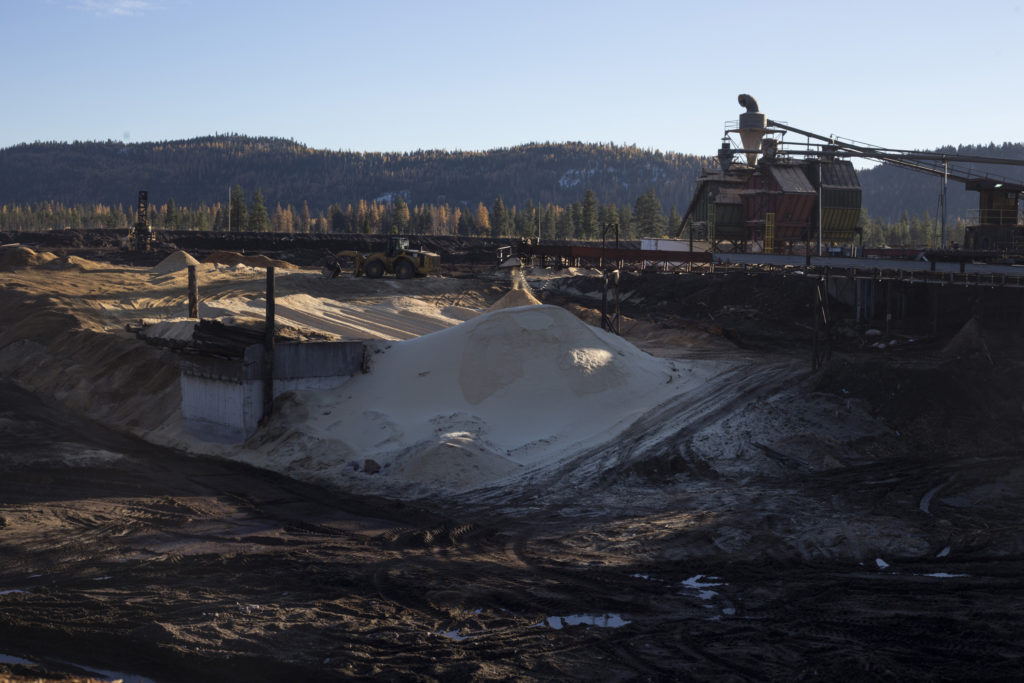
“Unlike any other natural disaster, we treat fire by borrowing from everything else that this federal agency is supposed to be doing – really, stealing it,” said Zack Porter, western Montana field director for the Montana Wilderness Association.
Porter is a participating member of the Southwestern Crown Collaborative, a group of citizens that come together across party lines to collaborate on ways to mitigate wildfires in the region.
“We’ve got industry, people with wilderness interests, everybody at the table saying how do we do things,” said Gary Burnett, executive director of the Blackfoot Challenge, a nonprofit conservation group, and another member of the collaborative.
Forest Service District Ranger for the Lolo Forest Rachel Feigley said the collaborative has had a tangible impact, including helping with a project to thin the forest alongside Highway 83 near the Lolo Forest in Seeley Lake. She emphasized that with more available funds, the Forest Service could do more similar work.
“If we had more money, we’d be able to be more successful and do more,” Feigley said.
But not all legislation aimed at reducing wildfires has bipartisan support. Porter, with the Montana Wilderness Association, is among those decrying bills introduced by Congressman Bruce Westerman, (R-Arkansas) and Senator John Barrasso (R-Wyoming) that would speed up approvals for cutting down trees.
“The Westerman and Barrasso bills would gut bedrock environmental laws, strip the public of its right to weigh in on decisions, and open the door to unsustainable clearcut logging practices that we haven’t seen in half a century,” Porter said. “All without doing anything to address the fire situation. Harvesting vast tracts of our forests will not prevent fire seasons like the one we had this year.”
But when presented as a single-issue funding fix, the bill that would allow for disaster relief funding for fighting wildfires is one with broad bipartisan support, said Dylan Kruse, policy director for nonprofit Sustainable Northwest.

“This is the most bipartisan piece of legislation sitting before Congress,” Kruse said, referring to the Wildfire Disaster Funding Act. “I think both sides want a moderate solution; I think most people see the need to do more work and realize we need to do more restoration and more work in the woods.”
The Blackfoot Challenge’s Gary Burnett said the bill could even save money.
“If we’re trying to reduce the cost of fighting fire and then the fire comes and we lose the tools to be able to reduce the cost of fire, it becomes this never-ending cycle,” Burnett said. “We need to separate the cost of fighting fire from the cost of reducing the cost of fighting fire.”
Kruse said he is hopeful that there is enough momentum in Congress to avoid what he believes is a purely political roadblock — warnings from Republicans like House Speaker Ryan that the bill would increase federal spending.
“It’s been proven time and again by independent reviewers that this act would not increase federal spending,” Kruse said. “It’s money that is already being spent. Over 200 organizations representing diverse interests support this and in the last congressional session more than 150 bipartisan and bicameral members co-sponsored this.”
And there’s a new sense of urgency.
“We need a fire funding fix and we need it now,” Kruse said. “Otherwise we’re destined to repeat the same fate next year. The West simply cannot afford that any longer.”
 A version of this story appeared in FLATHEAD BEACON on December 5, 2017
A version of this story appeared in FLATHEAD BEACON on December 5, 2017








